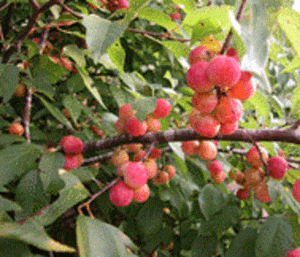Prunus rivularis facts for kids
Quick facts for kids Prunus rivularis |
|
|---|---|
 |
|
| Conservation status | |
| Scientific classification | |
 |
|
| Natural range (Prunus munsoniana) | |
| Synonyms | |
|
Prunus rivularis, also known as the creek plum, hog plum, or wild-goose plum, is a type of shrub that grows in thick groups. It likes soils that have lots of limestone or clay. This plant loses its leaves in the fall (it's deciduous) and is part of the rose family, called Rosaceae. You can mostly find it in the central United States.
The creek plum has thin stems with white flowers that grow in small bunches. Its fruit is a type of drupe, which looks like a big berry. Even though the fruit tastes a bit bitter, it's an important food source for birds and other wild animals. The name "Prunus" is Latin for plum, and "rivularis" means "near a stream."
Contents
What Does the Creek Plum Look Like?
The leaves of the creek plum are simple and grow one after another along the stems. They are usually oval-shaped and about 5-6 centimeters (2 to 2.4 inches) long and 2-3 centimeters (0.8 to 1.2 inches) wide. The edges of the leaves have small, sharp teeth, like a saw blade.
Flowers and Fruit
The flowers of this plant usually bloom in March or April. They grow in clusters of 2 to 8 flowers from where the leaves meet the stem. Each flower is about 12-16 millimeters wide and has 5 white petals. There are about 20 stamens (the parts that make pollen) with yellowish tips.
The fruit ripens in late July. It's a round, orange-red fruit, about 17-22 millimeters long and wide. Inside, it has a juicy, fleshy part and a hard, stony pit. Even though it's juicy, it can taste quite bitter. The fruit can grow alone or in small groups of 2 or 3.
Where Does the Creek Plum Grow?
The Prunus rivularis is native to the United States. You can find it in states like Arkansas, Illinois, Kansas, Kentucky, Louisiana, Mississippi, Missouri, Ohio, Oklahoma, Tennessee, and Texas.
It likes to grow in many different natural places. You might see it along creeks, in wooded canyons, at the bottom of valleys, or in floodplains. This plant prefers soils that are based on limestone or sandy soil. The soil can be dry or moist, but it needs to drain water well. This means water doesn't sit around for too long. It can handle a wide range of temperatures, from very cold to quite warm, which is why it grows in so many different states.
Creek Plum and Nature
The creek plum is a perennial plant, which means it lives for more than two years. The fruits it produces are a favorite food for many birds and other animals. Its flowers are also great for attracting insects like butterflies and bees, which help pollinate the plant.
Medicinal Uses
Some parts of the Prunus plant family, including the creek plum, contain certain natural compounds. These compounds can be harmful if eaten in large amounts, especially the leaves and seeds. It's always best not to eat wild plants unless you are sure they are safe and know how to prepare them.
How People Use the Creek Plum
The leaves of the creek plum can be used to make natural dyes. These dyes can create colors ranging from green to dark gray.
Long ago, Native American tribes in Texas used to eat the fruit of the creek plum.
Images for kids




